1-3-1 extended Greenberg
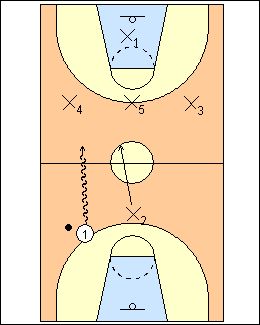 | 1 Seth Greenberg Why use an extended 1-3-1 zone ("13")? - unique and difficult to prepare for - change of pace - get easy baskets - extremely effective against transition teams, stop the ball early, the defence is back - it's good with a lead, teams get impatient - use it early, can go back to it later, but don't use it against all teams. Teaching points are Keep the ball out of the middle and out of the high post. The point and wings must be constantly aware of and distort passing lanes, forcing passes over and around them, moving on air time. Point X2 is long, athletic, picks the ball up 3/4 court, bluffs and retreats, gets the ball out of the middle then distorts the guard to guard pass. He rebounds from the middle. The wings start high (the old hash mark), distort the guard to forward pass, and push the ball out on a pass to a wing, ignoring what's behind them. Point guard X1 is on the baseline. Most teams end up 2-1-2 against a 1-3-1 and most shots are from the corner or from the wing on a diagonal skip pass, so Greenberg is not too worried about rebounding if the wings do their job. |
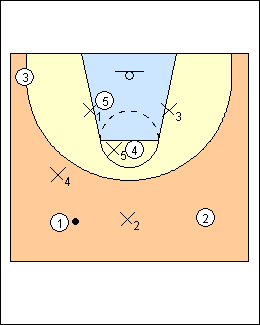 | 2 X5 has the middle of the defence, with the ball on the wing he keeps the ball out of the high post one full step beyond the arc, denies from the side, goes behind on a guard-to-guard pass. X1 plays the high side of low-post attacker 5, sitting on his top leg, and takes any pass below the first lane marker. He can't get screened on a pass to the corner. Wings X4 and X3 mirror each other, X3 has the diagonal, X4 distorts the passing lane to 3 (X1 talks to him) with soft pressure, always checking over his shoulder, bluffing and retreating. If a ballhandler picks up the dribble, point X2 and the wings will back up in the passing lanes, a soft trap. |
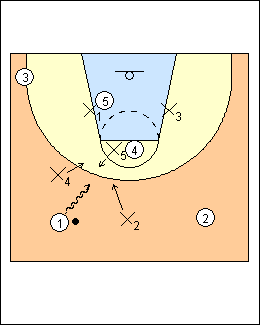 | 3 X5 attacks all middle penetration, he steps up, the point guard and ballside wing pinch (stay), forming a cup, almost a triple-team, X1 and the weakside wing cover the blocks. On a pass to 3, X1 would close out and X4 soft trap (see below). |
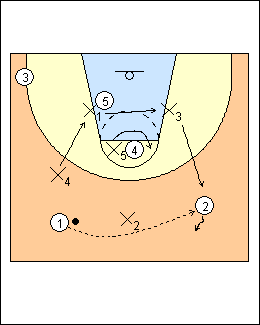 | 4 On a guard-to-guard pass, X3 doesn't worry about what's behind him, he attacks the ball and pushes it out, forcing a back dribble, buying time for wing X4 to take away a weakside diagonal pass. |
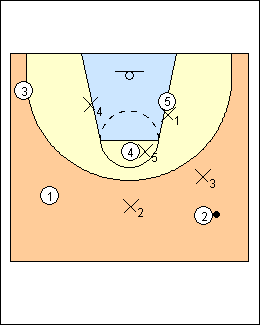 | 5 X3 can then bluff and retreat, concern himself with a pass to the corner. |
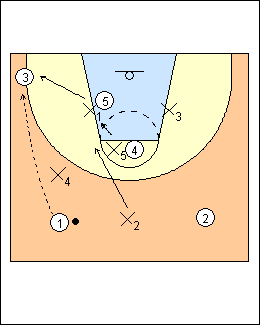 | 6 On a pass to the corner, X1 closes out hard, taking away baseline but square to the ball. |
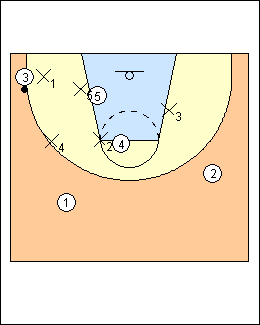 | 7 X4 soft traps, facing the ball in the passing lane out to 1, and attacks penetration if 3 dribbles out of the corner.X2 keeps the ball out of the high post (the elbow), and distorts the skip pass to 2 with high hands. X3 has the diagonal pass, he will sit on the top leg of an attacker not to get screened on a pass to 2. Rebounders run to the ball. On a shot from the corner, ballside X4 runs to the middle of the lane to create a rebounding triangle with X3 and X5. X2 rebounds from the middle. X1 has long ballside rebounding, and is in good position for an outlet pass. On a pass out to 1, X4 pushes the ball out, X1 recovers to the block. |
 | 8 On a skip pass out of the corner, wing X3 pushes the ball out, buying time, X1 gets to the ballside block (and can then get to a pass to the ballside corner), X4 drops and has weakside. X5 comes up on any pass out of the corner, he can't stay flat. |
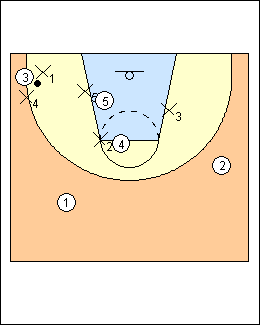 | 9 Trap a good shooter in the corner, the other slides do not change. On a pass to 1, X4 will push the ball out but not as aggressively for a shorter run to trap the shooter in the corner. |
This page was made with Basketball playbook from Jes-Soft